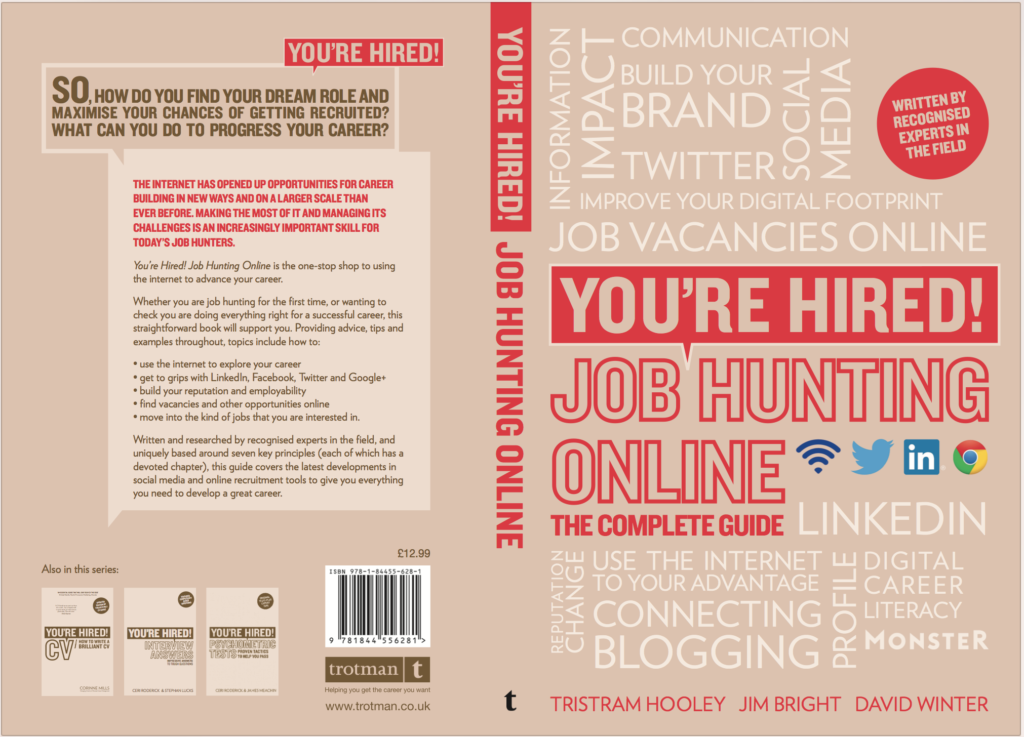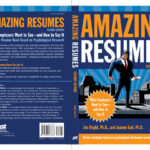10 steps to develop your online brand
This is an extract from our new book on the 10 steps to develop your online brand, published today called You’re Hired! Job Hunting Online: The Complete Guide. by Tristram Hooley, Jim Bright and David Winter. Published by Trotman.
1. Decide what it is you have to offer.
The first step in the 10 steps to develop your online brand is to decide what you have to offer. For instance, you might have a law degree or be an excellent user of Photoshop.
2. Think about what you want.
For instance, you may want a job as a corporate lawyer or a graphic artist. Thinking about what you want helps you to clarify what content you need to create and who you would like to read it.
3. Decide who you want to talk to.
It is important to know your audience. What are they looking for? What are their expectations in terms of presentation, customer service, professionalism and expertise? Also consider, what gets your customers interested and excited? For instance, corporate lawyers are likely to expect a corporate and reasonably serious presentation. They will expect ethical behaviour, so no sharing indiscreet remarks about clients or yourself. They are likely to get excited about legal updates, information about potential clients, stories of lessons learned from the corporate legal world, information about what is coming next or the next big thing in their world, and most importantly how to improve their practice and profi tability. Personal interest stories that your readers can use as examples in their own work are also likely to be popular.
4. Do something.
You will only build your brand by putting yourself and your content out there. It can be frightening at fi rst but you need to push through that and actually post. Start by being extra careful and cautious, but recognise that practice makes perfect and that you will fi nd each public post easier than the last.
5. Be consistent and reasonably focused.
Treat your audience with respect. Treat them as though they have paid to come into your theatre and are expecting a good show. This means sticking to a subject area or topic, and not straying too far from this. In the same way, many actors can lose credibility and our patience when they start pontifi cating about political matters: your audience doesn’t care about your cat, your passion for tiddlywinks or other topics unrelated to your expertise. You may have strong views on the decline in church architecture in the 19th century, but sadly nobody cares if they are there to read about new innovations in transporting. We are halfway through our 10 steps to develop your online brand!
6. Be careful in your use of different platforms.
If LinkedIn is the formal business meeting, Twitter the business text message, then Facebook is the conference bar, or weekend company event. Although it may be expected that you are more personal and forthcoming on Facebook compared to the other platforms, if you choose to allow potential employers or colleagues access to all three platforms, then it is important that the way you present appears to be shades on a continuum rather than Dr Jekyll and Mr Hyde.
7. Don’t trash your brand.
Many years ago, Gerald Ratner, then Chairman of the jewellery company bearing his name, described their best- selling product in a public meeting at the Royal Albert Hall as ‘total crap’. The reaction was instantaneous – £500 million wiped off the value of the company that very nearly collapsed, and Ratner himself was sacked within the year. This happened before the time of social media! These days that remark may well have led to an irreversible collapse. Don’t do a Gerald on yourself!
8. Develop a style and stick to it.
Usually the best style is write as you sound in real life – in other words, try to be authentic. It might take some experimentation to work out which style works for you. For instance, if you are not very funny, leave it to those who are. There are many difference ‘voices’ you could adopt including: fair- minded; independent; factual; critical; sarcastic; satirical; humorous; up- to- the- minute; a sharer; an originator of ideas; a supporter; a representative; a booster of other initiatives; the insider’s perspective; the view from the top; the voice of the masses; the customer; the technical wizard; the helper; the objector; myth buster; taboo breaker; campaigner or the spokesperson for a group. You do not necessarily have to adopt only one voice, but trying to speak in too many different voices is likely to confuse your readers and even alienate some who have come to expect or prefer one of the other voices
9. Keep on keeping on.
The last but one step in our 10 steps to develop your online brand is persistence. Your brand will be built slowly across thousands of small acts and conversations. Setting up a LinkedIn profi le or a blog is great, but it is only when you start to use this regularly that it really starts to have an impact.
10. Review how it is going.
There is no point in banging your head against a brick wall. It is important to spend a bit of time thinking about what you are doing that is working. Many social media platforms offer you a range of statistics. Have a look at these and see who is looking at you (and who is not). Are you unexpectedly big in China? Is there a topic that you talk about that everyone seems interested in. Once you find out what things are working, then do more of them!
Extract from our new book published today You’re Hired! Job Hunting Online: The Complete Guide by Tristram Hooley, Jim Bright and David Winter
Related Posts







